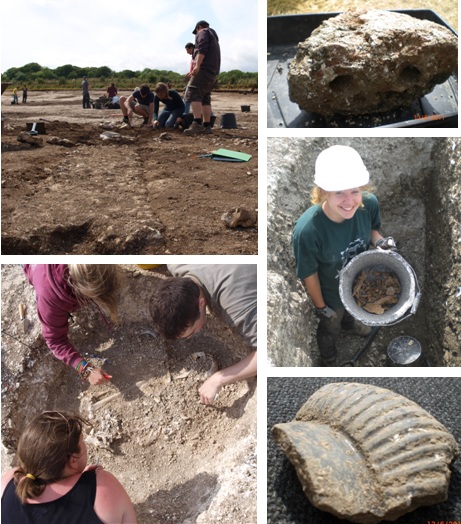Yesterday saw the site being washed out. However, while the heavy rain stopped excavation for the day, it turned out a blessing in disguise as it dampened the ground and washed away a blanket of fine dust masking some unexcavated features. This highlighted fifteen additional pit and ditch features, including a buried wall line. I suspect the diggers were relieved at not having to so extensively trowel and brush the site clean today because of the rain’s beneficial effects – and I expect they also enjoyed the extra day off to rest aching joints.
Most of the first years were keen to get stuck into their allocated features to recover artefacts that assist in interpreting the site further. It is evident that the site on a whole is extremely rich with artefacts, with numerous students requested more finds trays. On the other hand, some first years have discovered that, ‘X’ does not always make the spot, their features containing few finds
Finds for the day were numerous animal bones and pottery sherds. There was early to late Iron Age pottery recovered in pits, as well as an almost complete classic Durotrigian beaded rim pot with pedestal. It is believed that due to the position of these deliberately placed pots that they could be possible be a form of offerings. Moreover, at the bases of pits there have been found horse or cow skulls and one feature may hold not only a skull but the full skeleton of the animal, but this requires further excavation. An unusual discovery today was a large fired triangular block of clay with adjacent holes which has been suggested to be some form of a weight, either for a loom, or for maintaining a net over thatching to hold down the straw on the roof.
Spirits have not been damped by the presence of mud over the site, as there has been more exciting recoveries of human remains. After hours of cautious excavating of the sketetal remains with brushes and minute implements two out of three burials have been exposed. The first burial was of a baby near the Roman building platform. The second burial was a crouched burial which also contained a pottery vessel. The third burial was in the neighbouring, which at this moment in time has only part of a pelvis and femur have been exposed. Watch this space for future insights into the manner in which these individuals lived and died.
